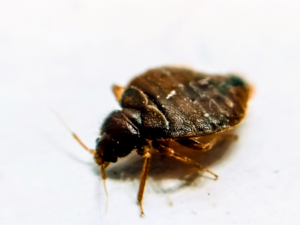Home / Blog / What Are the Signs of a Moth Infestation?
What Are the Signs of a Moth Infestation?

Scientifically reviewed by Daniel Baldwin, BCE, CCFS, CP-FS
-Published on September 7, 2022
-Updated on March 7, 2025
Most of us know that moths have a penchant for eating fabric and can wreak havoc on a closet full of clothes. But how do they actually get into our homes and find stored clothing? And how can you get rid of them once they are inside? Learn more about moths and then find the pest control method that works best for you and your family.
What Are Moths?
Moths are flying insects in the order of Lepidoptera, which is Latin for “scale” and “wing,” and includes butterflies as well. As moths are nocturnal, they’ll usually spend their days looking for a dark place to hide out (like in your house or basement), only to be drawn to light sources like lamps that illuminate the darkness. While moth appearance can vary based on type and breed, most are tan or mottled brown with whitish wings.

Types of Moths
There are up to 487 different kinds of moths native to North America, according to some identification databases. However, some types are much more common than others. Here are some of them:
- Hummingbird Clearwing Moth (common in gardens and flowering plants)
- Fall Webworm Moth (caterpillars are extremely destructive to trees)
- Cecropia Moth (7-inch wingspan makes it the largest in North America)
- Brown House Moth (not harmful, just invasive)
- Io Moth (wing markings that look like eyes to scare predators)
- Polyphemus Moth (named after a Cyclops in Greek mythology due to large “eye” patterns on its wings)
- Twin-spotted Sphinx Moth (nocturnal and attracted to light sources)
- Common Clothes Moth (what you’ll likely see around your house eating fabrics)
- Isabella Tiger Moth (“wooly bear” caterpillars you liked as a kid)
- Luna Moth (the prettiest moth in North America)
Moth Life Cycle
Moths start their life cycles in the early part of spring. For the next 2–4 weeks, they’re developing and, eventually, mating. Like butterflies, they hatch from eggs and later transition into larvae before entering the cocoon and finally emerging as adult moths.
An adult female moth can lay between 40–100 eggs in her lifetime. A moth’s life span can range anywhere between 1 and 6 months, depending on the kind of moth.
What Do Moths Eat?
In the wild, adult moths subsist largely on nectar from flowers. This liquid diet is consumed through a proboscis (straw) that allows them to dig deep for that syrupy goodness in the forest.
Once they’re in your home however, moths like to eat organic fibers like wool and cotton, which means they like clothing, rugs, blankets, and curtains. Sometimes, the damage isn’t visible to the naked eye until the integrity of the item starts to deteriorate, but unfortunately moth damage is often noticeable in the form of large holes.
Sweat, food stains, and urine can attract moths to fabrics so it’s important to clean any soiled items as soon as you can to avoid attracting moths. It’s also important to clean any second-hand clothing before storing it away because moths could have laid eggs on them in their previous home. Some moths prefer pantry goods over clothes and fabrics. To help prevent this, seal up all open food containers and try to minimize crumbs and other food debris.

Do Moths Bite?
Most moths aren’t interested in biting people. Some moth larvae can cause skin irritation where they come into contact with skin, due to their hair-like spines. This irritation can look similar to an allergic reaction. And in case you were considering it, some moths are poisonous if eaten.
What Are the Signs of a Moth Infestation?
Holes in clothing are probably the most obvious signs of a moth infestation in your house. Similar damage to other wool or cotton fabrics in your home should confirm that moths are present.
Some other signs of a moth infestation can include:
- Slight webbing residue left in and around the affected food or fabrics
- Moths in flight inside your home (fun fact: It’s not these moths that do the damage; it’s actually their larvae)
How To Prevent Moth Infestations
Moth repellents like cedar wood are a great natural option to repel them from your closets or around your pantry. It’s also good practice to inspect and wash new clothes before putting them away or wearing them (yes, even new clothing).
Some other ways to keep moths out of your home include:
- Keeping your windows closed at night or installing insect screens to keep moths (and other pests) out of your space
- Sealing up any open cracks or broken window screens to keep new moths from flying in
- Inspecting groceries and bags before you unload them into your pantry
How To Get Rid of Moths In Your Home
If you already have a moth infestation inside your home, there is a relatively simple 4-step process that you can try before opting to contact a pest control professional.
- Find out if you’re dealing with pantry moths or clothes moths (because that will help you narrow your search and prioritize the area and treatment you need).
- Pantry moths often fly farther away from their food source, looking for more food. You also might notice more webbing from moth larvae in or around your food.
- Clothes moths are harder to spot, but the damage to your sweaters will be obvious. They also stay much closer to their food source, so if you see holes in your clothing, you know they won’t be too far away.
- Throw away any fabrics or foods that show obvious signs of infestation.
- Close up any openings in your windows, walls, or foundation.
- Keep your home clean so new infestations don’t occur.
If you’re dealing with pantry moths, traps work best. Moth balls can kill clothing moths on some occasions, but moth balls have a lasting unpleasant odor and aren’t safe around kids or pets. Some choose to try an at-home spray made from lavender or mint essential oils, although this method is not proven to work and these oils may stain any fabrics you spray them on.
To address a moth problem, contact Hawx Pest Control. Our treatment methods target moth larvae and effectively remove any moth families before a new life cycle begins.
Related Articles
Visit our blog to learn more.
→





